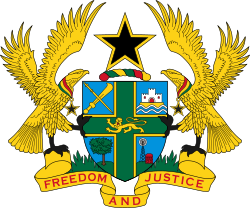The coat of arms of Ghana was designed by Ghanaian artist Nii Amon Kotei and was introduced on 4 March 1957.[1]
| Coat of arms of Ghana | |
|---|---|
 | |
| Armiger | Republic of Ghana |
| Adopted | 4 March 1957 |
| Crest | A black star bordered in gold |
| Torse | Gold, green and red |
| Shield | Azure on a cross vert fimbriated Or a lion passant guardant Or, in the first quarter a linguist's staff and ceremonial sword crossed in saltire Or, in the second quarter issuant from five bars wavy Argent and Azure a castle Argent upon a mount Or, in the third quarter affixed in a grassy plain a cocoa tree proper and in the fourth quarter upon a grassy plain a mine proper. |
| Supporters | Two eagles displayed Or around each of whose neck hangs a black star fimbriated Or suspended from a ribbon tierced gules, Or and vert upon a grassy compartment proper |
| Motto | Freedom and Justice |
| Earlier version(s) |  Gold Coast |
| Use | 1877-1957 |
Description edit
- The first quarter, on the upper left shows a sword used by chiefs, and a staff, used by the linguist (known as an okyeame in Akan), at ceremonies. It is a symbol for the traditional authority of Ghana.
- The second quarter shows a representation of Osu Castle on the sea, the presidential palace on the Gulf of Guinea, symbolizes the national government.
- The third quarter of the shield shows a cocoa tree, which embodies the agricultural wealth of Ghana.
- The fourth quarter shows a gold mine, which stands for the richness of industrial minerals and natural resources in Ghana.
- A gold lion centred on a green St George's Cross with gold fimbriation on the field of blue, represents the continuing link between Ghana and the Commonwealth of Nations.
- The crest is a Black star of Africa with gold outline, upon a torse in the national colours.
- Supporting the shield are two golden Tawny eagles, with the Order of the Star of Ghana suspended from their necks.
- The compartment upon which the supporters stand is composed of a grassy field, under which a scroll bears the national motto of Ghana: Freedom and Justice. The shield stands for a weapon which helps to fight poverty, ignorance and hunger
History edit
British Gold Coast edit
-
1821-1837
-
1837-1877
Danish Gold Coast edit
-
1658-1699.
-
1699-1819.
-
1819-1855.
Dutch Gold Coast edit
-
1612-1665.
-
1665-1795.
-
1795-1802.
-
1802-1806.
-
1808-1810.
-
1810-1814.
-
1814-1815.
-
1815-1872.
English Gold Coast edit
-
1631-1637.
-
1663-1688.
-
1694-1700.
Brandenburger/Prussian Gold Coast edit
-
1682-1688
-
1688-1721
Portuguese Gold Coast edit
-
1482-1557.
-
1557-1578.
-
1578-1580.
-
1580-1640.
-
1640-1642.
Swedish Gold Coast edit
-
1650-1654.
-
1654-1663.
External links edit
- Media related to Coats of arms of Ghana at Wikimedia Commons
References edit
- ^ "The nation's Coat of Arms". THE GHANAIAN TIMES. 6 March 2007. Archived from the original on 23 July 2011. Retrieved 25 October 2010.